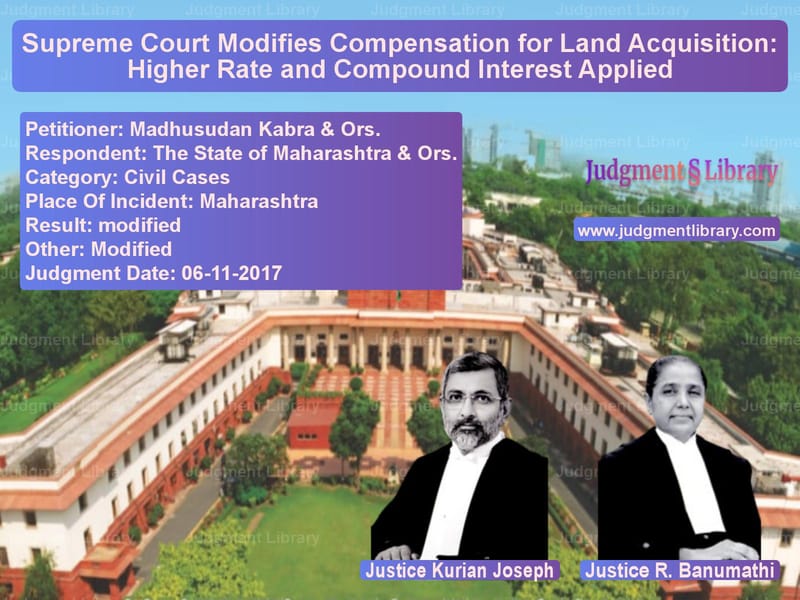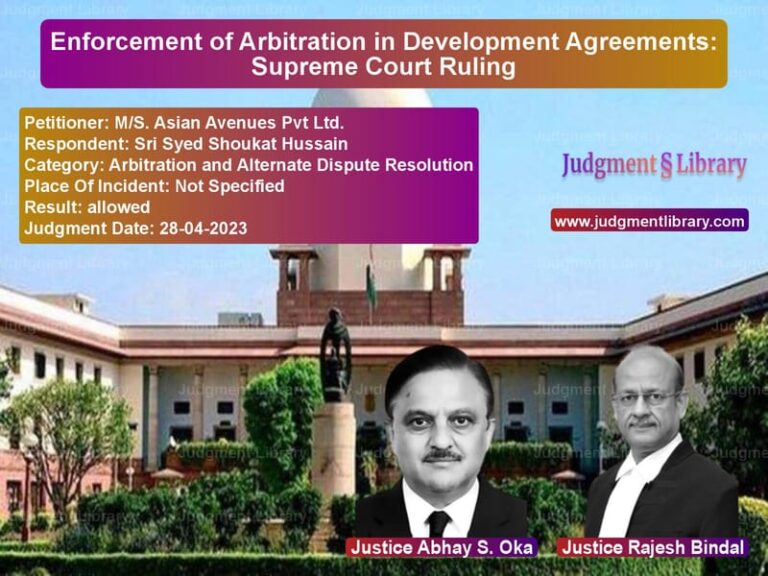Supreme Court Modifies Compensation for Land Acquisition: Higher Rate and Compound Interest Applied
The Supreme Court of India recently ruled on the case of Madhusudan Kabra & Ors. vs. The State of Maharashtra & Ors., addressing the issue of land acquisition compensation. The case revolved around the fairness of compensation granted for land acquired for a canal project under the Land Acquisition Act, 1894. The Supreme Court modified the High Court’s order, increasing the compensation amount by applying a higher annual increase and compounding interest.
Background of the Case
The dispute arose when land belonging to the appellants was acquired in 1992 under a Notification under Section 4(1) of the Land Acquisition Act, 1894. The Land Acquisition Collector relied on a 1988 exemplar (a comparable land transaction) to determine the land’s value, setting compensation at Rs. 23,500 per hectare.
The appellants, dissatisfied with the compensation, sought an increase before the Reference Court. However, the Reference Court declined any enhancement. They then appealed to the High Court, which acknowledged the four-year gap between the acquisition year (1992) and the exemplar year (1988). The High Court granted a 10% annual increase on the 1988 exemplar value, increasing the compensation to Rs. 32,000 per hectare.
Still dissatisfied, the appellants approached the Supreme Court, seeking further enhancement and questioning the method of applying the annual increase.
Arguments of the Petitioners (Madhusudan Kabra & Ors.)
- The appellants argued that the 10% annual increase applied by the High Court was too low and did not reflect actual market appreciation.
- They contended that the increase should have been applied at a higher rate, considering inflation and market trends.
- They also sought a compounding interest calculation rather than a simple annual increase.
- They pointed out that they had not been compensated separately for the fruit-bearing trees on the acquired land.
Arguments of the Respondents (State of Maharashtra)
- The respondents defended the compensation amount determined by the High Court.
- They maintained that the 10% annual increase was reasonable and consistent with past cases.
- They opposed the demand for compounding interest, arguing that simple interest had been the standard approach in similar cases.
Supreme Court’s Observations and Judgment
The Supreme Court examined the case and ruled that the compensation amount should be adjusted using a higher annual increase and compounded interest.
1. Higher Annual Increase of 15%
The Court acknowledged that the market value of land typically increases at a rate higher than 10% per year. It stated:
“Having regard to the facts and circumstances of this case, we are of the view that the interests of justice would be served by fixing annual increase on the exemplar, in the peculiar facts of this case, by 15% at compounding rate.”
2. Compensation for Fruit-Bearing Trees
The appellants had argued that their compensation should include separate payment for fruit-bearing trees. The Supreme Court did not explicitly grant this relief but factored the additional value into the revised compensation.
3. Compounding Instead of Simple Interest
The Supreme Court rejected the simple interest method used by the High Court and ruled that the annual increase should be applied on a compound basis to reflect real market appreciation.
4. No Additional Statutory Benefits Due to Delay
The Court noted that the appellants had delayed in raising their claims and had already received some benefits under the Land Acquisition Act. It ruled:
“As we have already made it clear vide our order dated 12.08.2016, the appellant would not be entitled for any statutory benefits for the period of delay.”
Final Judgment
The Supreme Court modified the High Court’s order and increased the compensation by:
- Applying a 15% annual increase instead of 10%.
- Using compounded interest instead of simple interest.
- Factoring in the value of fruit-bearing trees.
The respondents were directed to deposit the revised compensation with the Executing Court within three months.
Conclusion
The Supreme Court’s ruling emphasizes the importance of ensuring fair compensation in land acquisition cases. By adjusting the compensation method to reflect real market appreciation, the Court protected the rights of landowners while maintaining fairness in government acquisition policies.
This judgment sets a precedent for future land acquisition cases, ensuring that compensation calculations take into account both time-based market appreciation and agricultural value of the land.
Don’t miss out on the full details! Download the complete judgment in PDF format below and gain valuable insights instantly!
Download Judgment: Madhusudan Kabra & O vs The State of Maharas Supreme Court of India Judgment Dated 06-11-2017.pdf
Direct Downlaod Judgment: Direct downlaod this Judgment
See all petitions in Damages and Compensation
See all petitions in Property Disputes
See all petitions in Landlord-Tenant Disputes
See all petitions in Judgment by Kurian Joseph
See all petitions in Judgment by R. Banumathi
See all petitions in Modified
See all petitions in Modified
See all petitions in supreme court of India judgments November 2017
See all petitions in 2017 judgments
See all posts in Civil Cases Category
See all allowed petitions in Civil Cases Category
See all Dismissed petitions in Civil Cases Category
See all partially allowed petitions in Civil Cases Category







